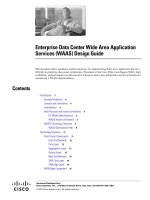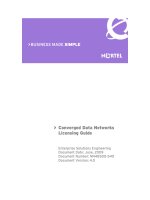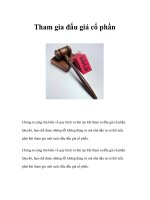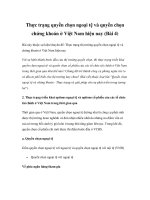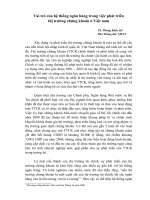Tài liệu Protein Data Bank Contents Guide: Atomic Coordinate Entry Format Description Version 3.20 Document Published by the wwPDB ppt
Bạn đang xem bản rút gọn của tài liệu. Xem và tải ngay bản đầy đủ của tài liệu tại đây (868.82 KB, 205 trang )
Protein Data Bank Contents Guide:
Atomic Coordinate Entry Format Description
Version 3.20
Document Published by the wwPDB
This format complies with the PDB Exchange Dictionary (PDBx)
/>
©2008 wwPDB
PDB File Format v. 3.2
Page i
Table of Contents
1. Introduction................................................................................................................................... 1
Basic Notions of the Format Description ............................................................................................3
Record Format....................................................................................................................................5
Types of Records................................................................................................................................6
PDB Format Change Policy................................................................................................................9
Order of Records ..............................................................................................................................10
Sections of an Entry..........................................................................................................................12
Field Formats and Data Types .........................................................................................................14
2. Title Section................................................................................................................................ 16
HEADER...........................................................................................................................................16
OBSLTE............................................................................................................................................19
TITLE ................................................................................................................................................21
SPLIT (added) ..................................................................................................................................22
CAVEAT ...........................................................................................................................................23
COMPND (updated) .........................................................................................................................24
SOURCE (updated) ..........................................................................................................................26
KEYWDS ..........................................................................................................................................31
EXPDTA (updated) ...........................................................................................................................33
NUMMDL (added).............................................................................................................................35
MDLTYP (added)..............................................................................................................................36
AUTHOR...........................................................................................................................................38
REVDAT (updated)...........................................................................................................................40
SPRSDE ...........................................................................................................................................42
JRNL (updated) ................................................................................................................................44
REMARK ..........................................................................................................................................52
REMARKs 0-5......................................................................................................................... 52
REMARK 0 (added), Re-refinement notice ...............................................................................52
REMARK 1 (updated), Related publications .............................................................................54
REMARK 2 (updated), Resolution.............................................................................................60
REMARK 3 (updated), Final refinement information .................................................................62
Refinement using X-PLOR ........................................................................................................63
Refinement using CNS ..............................................................................................................65
Refinement using CNX ..............................................................................................................67
Refinement using REFMAC ......................................................................................................69
Refinement using NUCLSQ ......................................................................................................77
Refinement using SHELXL........................................................................................................81
Refinement using TNT/BUSTER ...............................................................................................83
Refinement using PHENIX ........................................................................................................86
Refinement using BUSTER-TNT...............................................................................................94
Example for Solution Scattering ................................................................................................99
Non-diffraction studies...............................................................................................................99
REMARK 4 (updated), Format ................................................................................................100
REMARK 5 (updated), Obsolete Statement ............................................................................100
PDB File Format v. 3.2
Page ii
REMARKs 6 - 99................................................................................................................... 101
REMARK 100 (updated), Deposition or Processing Site ...................................................... 101
REMARKs 200-265, Experimental Details............................................................................ 102
REMARK 200 (updated), X-ray Diffraction Experimental Details ............................................102
REMARK 205, Fiber Diffraction, Fiber Sample Experiment Details ........................................105
REMARKs 210 and 215/217, NMR Experiment Details ..........................................................105
REMARK 230, Neutron Diffraction Experiment Details ...........................................................107
REMARK 240 (updated), Electron Crystallography Experiment Details .................................110
REMARK 245 (updated), Electron Microscopy Experiment Details ........................................112
REMARK 247, Electron Microscopy details ............................................................................114
REMARK 250, Other Type of Experiment Details ...................................................................114
REMARK 265, Solution Scattering Experiment Details...........................................................115
REMARKs 280-290, Crystallographic Details ....................................................................... 117
REMARK 280, Crystal .............................................................................................................117
REMARK 285, CRYST1 ..........................................................................................................117
REMARK 290, Crystallographic Symmetry .............................................................................118
REMARK 300 (updated), Biomolecule ....................................................................................119
REMARK 350 (updated), Generating the Biomolecule ...........................................................121
Example – When software predicts multiple quaternary assemblies ......................................123
REMARK 375 (updated), Special Position ..............................................................................125
REMARK 400, Compound ......................................................................................................125
REMARK 450, Source.............................................................................................................126
REMARK 465 (updated), Missing residues .............................................................................126
REMARK 470 (updated), Missing Atom(s) ..............................................................................127
REMARK 475 (added), Residues modeled with zero occupancy ...........................................128
REMARK 480 (added), Polymer atoms modeled with zero occupancy ..................................129
REMARK 500 (updated), Geometry and Stereochemistry ......................................................130
REMARK 525 (updated), Distant Solvent Atoms ....................................................................136
REMARK 600, Heterogen .......................................................................................................136
REMARK 610, Non-polymer residues with missing atoms .....................................................138
REMARK 615, Non-polymer residues containing atoms with zero occupancy .......................138
REMARK 620 (added), Metal coordination .............................................................................139
REMARK 630 (added), Inhibitor Description ...........................................................................141
REMARK 650, Helix ................................................................................................................142
REMARK 700, Sheet...............................................................................................................143
REMARK 800 (updated), Important Sites ...............................................................................145
REMARK 999, Sequence ........................................................................................................147
3. Primary Structure Section ........................................................................................................ 148
DBREF (standard format) ...............................................................................................................148
DBREF1 / DBREF2 (added) ...........................................................................................................151
SEQADV.........................................................................................................................................152
SEQRES (updated) ........................................................................................................................155
MODRES (updated)........................................................................................................................157
4. Heterogen Section (updated) ................................................................................................... 159
HET.................................................................................................................................................159
HETNAM.........................................................................................................................................161
PDB File Format v. 3.2
Page iii
HETSYN .........................................................................................................................................163
FORMUL.........................................................................................................................................164
5. Secondary Structure Section.................................................................................................... 166
HELIX .............................................................................................................................................166
SHEET............................................................................................................................................168
6. Connectivity Annotation Section............................................................................................... 171
SSBOND (updated) ........................................................................................................................171
LINK (updated) ...............................................................................................................................173
CISPEP...........................................................................................................................................175
7. Miscellaneous Features Section .............................................................................................. 177
SITE................................................................................................................................................177
8. Crystallographic and Coordinate Transformation Section........................................................ 179
CRYST1..........................................................................................................................................179
ORIGXn ..........................................................................................................................................181
SCALEn ..........................................................................................................................................182
MTRIXn...........................................................................................................................................184
9. Coordinate Section................................................................................................................... 185
MODEL ...........................................................................................................................................185
ATOM .............................................................................................................................................187
ANISOU ..........................................................................................................................................189
TER.................................................................................................................................................192
HETATM .........................................................................................................................................194
ENDMDL.........................................................................................................................................196
10. Connectivity Section............................................................................................................... 197
CONECT.........................................................................................................................................197
11. Bookkeeping Section.............................................................................................................. 199
MASTER.........................................................................................................................................199
END ................................................................................................................................................201
PDB File Format v. 3.2
Page 1
1. Introduction
The Protein Data Bank (PDB) is an archive of experimentally determined three-dimensional
structures of biological macromolecules that serves a global community of researchers, educators,
and students. The data contained in the archive include atomic coordinates, crystallographic structure
factors and NMR experimental data. Aside from coordinates, each deposition also includes the
names of molecules, primary and secondary structure information, sequence database references,
where appropriate, and ligand and biological assembly information, details about data collection and
structure solution, and bibliographic citations.
This comprehensive guide describes the "PDB format" used by the members of the worldwide Protein
Data Bank (wwPDB; Berman, H.M., Henrick, K. and Nakamura, H. Announcing the worldwide Protein
Data Bank. Nat Struct Biol 10, 980 (2003)). Questions should be sent to
Information about file formats and data dictionaries can be found at .
Version History:
Version 2.3: The format in which structures were released from 1998 to July 2007.
Version 3.0: Major update from Version 2.3; incorporates all of the revisions used by the wwPDB to
integrate uniformity and remediation data into a single set of archival data files including IUPAC
nomenclature. See for more details.
Version 3.1: Minor addenda to Version 3.0, introducing a small number of changes and extensions
supporting the annotation practices adopted by the wwPDB beginning in August 2007 including chain
ID standardization and biological assembly .
Version 3.15: Minor addenda to Version 3.20, introducing a small number of changes and extensions
supporting the annotation practices adopted by the wwPDB beginning in October 2008 including
DBREF, taxonomy and citation information.
Version 3.20: Current version, minor addenda to Version 3.1, introducing a small number of changes
and extensions supporting the annotation practices adopted by the wwPDB beginning in December
2008 including DBREF, taxonomy and citation information.
September 15 2008, initial version 3.20.
November 15 2008, add examples for Refmac template and coordinate with alternate
conformation.
December 24 2008, update REMARK 3 templates/examples, add Norine database in DBREF,
update REMARK 500 on chiral center.
February 12 2009, update example in REMARK 210 and record format in NUMMDL
July 6 2009, update description for REVDAT, DBREF2, MASTER and extend number of
columns for AUTHOR, JRNL, CAVEAT, KEYWDS, etc.
December 22, 2009, update CAVEAT and REMARK 265.
April 21, 2010, update REMARK 5 and add BUSTER-TNT template in REMARK 3.
PDB File Format v. 3.2
Page 2
December 06, 2010, update maximum number of atoms for model. Update REMARK 3 with B
value type for Refmac template.
March 30, 2011, correct description and examples for FORMUL and CONECT records.
Change template in REMARK 630.
PDB File Format v. 3.2
Page 3
Basic Notions of the Format Description
Character Set
Only non-control ASCII characters, as well as the space and end-of-line indicator, appear in a PDB
coordinate entry file. Namely:
abcdefghijklmnopqrstuvwxyzABCDEFGHIJKLMNOPQRSTUVWXYZ
1234567890
` - = [ ] \ ; ' , . / ~ ! @ # $ % ^ & * ( ) _ + { } | : " < > ?
The use of punctuation characters in the place of alphanumeric characters is discouraged.
The space, and end-of-line:. The end-of-line indicator is system-specific character; some systems
may use a carriage return followed by a line feed, others only a line-feed character.
Special Characters
Greek letters are spelled out, i.e., alpha, beta, gamma, etc.
Bullets are represented as (DOT).
Right arrow is represented as -->.
Left arrow is represented as <--.
If "=" is surrounded by at least one space on each side, then it is assumed to be an equal sign, e.g., 2
+ 4 = 6.
Commas, colons, and semi-colons are used as list delimiters in records that have one of the following
data types:
List
SList
Specification List
Specification
If a comma, colon, or semi-colon is used in any context other than as a delimiting character, then the
character must be escaped, i.e., immediately preceded by a backslash, "\".
PDB File Format v. 3.2
Page 4
Example - Use of “\” character:
COMPND
COMPND
COMPND
COMPND
COMPND
COMPND
COMPND
2
3
4
5
6
7
MOL_ID: 1;
MOLECULE: GLUTATHIONE SYNTHETASE;
CHAIN: A;
SYNONYM: GAMMA-L-GLUTAMYL-L-CYSTEINE\:GLYCINE LIGASE
(ADP-FORMING);
EC: 6.3.2.3;
ENGINEERED: YES
COMPND
COMPND
COMPND
COMPND
COMPND
COMPND
COMPND
COMPND
2
3
4
5
6
7
8
MOL_ID: 1;
MOLECULE: S-ADENOSYLMETHIONINE SYNTHETASE;
CHAIN: A, B;
SYNONYM: MAT, ATP\:L-METHIONINE S-ADENOSYLTRANSFERASE;
EC: 2.5.1.6;
ENGINEERED: YES;
BIOLOGICAL_UNIT: TETRAMER;
OTHER_DETAILS: TETRAGONAL MODIFICATION
PDB File Format v. 3.2
Page 5
Record Format
Every PDB file is presented in a number of lines. Each line in the PDB entry file consists of 80
columns. The last character in each PDB entry should be an end-of- line indicator.
Each line in the PDB file is self-identifying. The first six columns of every line contains a record name,
that is left-justified and separated by a blank. The record name must be an exact match to one of the
stated record names in this format guide.
The PDB file may also be viewed as a collection of record types. Each record type consists of one or
more lines.
Each record type is further divided into fields.
Each record type is detailed in this document. The description of each record type includes the
following sections:
•
•
•
•
•
•
•
Overview
Record Format
Details
Verification/Validation/Value Authority Control
Relationship to Other Record Types
Examples
Known Problems
For records that are fully described in fixed column format, columns not assigned to fields must be left
blank.
PDB File Format v. 3.2
Page 6
Types of Records
It is possible to group records into categories based upon how often the record type appears in an
entry.
One time, single line: There are records that may only appear one time and without continuations in a
file. Listed alphabetically, these are:
RECORD TYPE
DESCRIPTION
-----------------------------------------------------------------------------------CRYST1
Unit cell parameters, space group, and Z.
END
Last record in the file.
HEADER
First line of the entry, contains PDB ID code,
classification, and date of deposition.
NUMMDL
Number of models.
MASTER
Control record for bookkeeping.
ORIGXn
Transformation from orthogonal coordinates to the
submitted coordinates (n = 1, 2, or 3).
SCALEn
Transformation from orthogonal coordinates to fractional
crystallographic coordinates (n = 1, 2, or 3).
It is an error for a duplicate of any of these records to appear in an entry.
One time, multiple lines: There are records that conceptually exist only once in an entry, but the
information content may exceed the number of columns available. These records are therefore
continued on subsequent lines. Listed alphabetically, these are:
RECORD TYPE
DESCRIPTION
----------------------------------------------------------------------------------AUTHOR
List of contributors.
CAVEAT
Severe error indicator.
COMPND
Description of macromolecular contents of the entry.
EXPDTA
Experimental technique used for the structure determination.
MDLTYP
Contains additional annotation pertinent to the coordinates
presented in the entry.
KEYWDS
List of keywords describing the macromolecule.
OBSLTE
Statement that the entry has been removed from distribution
and list of the ID code(s) which replaced it.
SOURCE
Biological source of macromolecules in the entry.
SPLIT
List of PDB entries that compose a larger
macromolecular
PDB File Format v. 3.2
Page 7
complexes.
SPRSDE
List of entries obsoleted from public release and replaced by
current entry.
TITLE
Description of the experiment represented in the entry.
The second and subsequent lines contain a continuation field, which is a right-justified integer. This
number increments by one for each additional line of the record, and is followed by a blank character.
Multiple times, one line: Most record types appear multiple times, often in groups where the
information is not logically concatenated but is presented in the form of a list. Many of these record
types have a custom serialization that may be used not only to order the records, but also to connect
to other record types. Listed alphabetically, these are:
RECORD TYPE
DESCRIPTION
----------------------------------------------------------------------------------ANISOU
Anisotropic temperature factors.
ATOM
Atomic coordinate records for standard groups.
CISPEP
Identification of peptide residues in cis conformation.
CONECT
Connectivity records.
DBREF
Reference to the entry in the sequence database(s).
HELIX
Identification of helical substructures.
HET
Identification of non-standard groups heterogens).
HETATM
Atomic coordinate records for heterogens.
LINK
Identification of inter-residue bonds.
MODRES
Identification of modifications to standard residues.
MTRIXn
Transformations expressing non-crystallographic symmetry
(n = 1, 2, or 3). There may be multiple sets of these records.
REVDAT
Revision date and related information.
SEQADV
Identification of conflicts between PDB and the named
sequence database.
SHEET
Identification of sheet substructures.
SSBOND
Identification of disulfide bonds.
PDB File Format v. 3.2
Page 8
Multiple times, multiple lines: There are records that conceptually exist multiple times in an entry, but
the information content may exceed the number of columns available. These records are therefore
continued on subsequent lines. Listed alphabetically, these are:
RECORD TYPE
DESCRIPTION
------------------------------------------------------------------------------FORMUL
Chemical formula of non-standard groups.
HETNAM
Compound name of the heterogens.
HETSYN
Synonymous compound names for heterogens.
SEQRES
Primary sequence of backbone residues.
SITE
Identification of groups comprising important entity sites.
The second and subsequent lines contain a continuation field which is a right-justified integer.
This number increments by one for each additional line of the record, and is followed by a blank
character.
Grouping: There are three record types used to group other records.
Listed alphabetically, these are:
RECORD TYPE
DESCRIPTION
-----------------------------------------------------------------------------------ENDMDL
End-of-model record for multiple structures in a single
coordinate entry.
MODEL
Specification of model number for multiple structures in a
single coordinate entry.
TER
Chain terminator.
The MODEL/ENDMDL records surround groups of ATOM, HETATM, ANISOU, and TER records.
TER records indicate the end of a chain.
Other: The remaining record types have a detailed inner structure.
Listed alphabetically, these are:
RECORD TYPE
DESCRIPTION
----------------------------------------------------------------------------------JRNL
Literature citation that defines the coordinate set.
REMARK
General remarks; they can be structured or free form.
PDB File Format v. 3.2
Page 9
PDB Format Change Policy
The wwPDB will use the following protocol in making changes to the way PDB coordinate entries are
represented and archived. The purpose of the policy is to allow ample time for everyone to
understand these changes and to assess their impact on existing programs. PDB format
modifications are necessary to address the changing needs of PDB users as well as the changing
nature of the data that is archived.
1.
Comments and suggestions will be solicited from the community on specific problems and
data representation issues as they arise.
2.
Proposed format changes will be disseminated through and wwpdb.org.
3.
A 60-day discussion period will follow the announcement of proposed changes. Comments
and suggestions must be received within this time period. Major changes that are not upwardly
compatible will be allotted up to twice the standard amount of discussion time.
4.
The wwPDB will then work in consultation with the wwPDB Advisory Committee and the
equivalent partner Scientific Advisory Committees to evaluate and reconcile all suggestions.
The final decision will be officially announced via and wwpdb.org.
5.
Implementation will follow official announcement of the format change. Major changes will
not appear in PDB files earlier than 60 days after the announcement, allowing sufficient time to
modify files and programs.
PDB File Format v. 3.2
Page 10
Order of Records
All records in a PDB coordinate entry must appear in a defined order. Mandatory record types are
present in all entries. When mandatory data are not provided, the record name must appear in the
entry with a NULL indicator. Optional items become mandatory when certain conditions exist. Record
order and existence are described in the following table:
RECORD TYPE
EXISTENCE
CONDITIONS IF OPTIONAL
-------------------------------------------------------------------------------------HEADER
Mandatory
OBSLTE
Optional
Mandatory in entries that have been
replaced by a newer entry.
TITLE
Mandatory
SPLIT
Optional
Mandatory when large macromolecular
complexes are split into multiple PDB
entries.
CAVEAT
Optional
Mandatory when there are outstanding errors
such as chirality.
COMPND
Mandatory
SOURCE
Mandatory
KEYWDS
Mandatory
EXPDTA
Mandatory
NUMMDL
Optional
Mandatory for NMR ensemble entries.
MDLTYP
Optional
Mandatory for NMR minimized average
Structures or when the entire polymer chain
contains C alpha or P atoms only.
AUTHOR
Mandatory
REVDAT
Mandatory
SPRSDE
Optional
Mandatory for a replacement entry.
JRNL
Optional
Mandatory for a publication describes
the experiment.
REMARK 0
Optional
Mandatory for a re-refined structure
REMARK 1
Optional
REMARK 2
Mandatory
REMARK 3
Mandatory
REMARK N
Optional
Mandatory under certain conditions.
PDB File Format v. 3.2
Page 11
DBREF
Optional
Mandatory for all polymers.
DBREF1/DBREF2
Optional
Mandatory when certain sequence database
accession and/or sequence numbering
does not fit preceding DBREF format.
SEQADV
Optional
Mandatory if sequence conflict exists.
SEQRES
Mandatory
Mandatory if ATOM records exist.
MODRES
Optional
Mandatory if modified group exists in the
coordinates.
HET
Optional
Mandatory if a non-standard group other
than water appears in the coordinates.
HETNAM
Optional
Mandatory if a non-standard group other
than water appears in the coordinates.
HETSYN
Optional
FORMUL
Optional
HELIX
Optional
SHEET
Optional
SSBOND
Optional
Mandatory if a disulfide bond is present.
LINK
Optional
Mandatory if non-standard residues appear
in a polymer
CISPEP
Optional
SITE
Optional
CRYST1
Mandatory
ORIGX1 ORIGX2 ORIGX3
Mandatory
SCALE1 SCALE2 SCALE3
Mandatory
MTRIX1 MTRIX2 MTRIX3
Optional
Mandatory if the complete asymmetric unit
must be generated from the given coordinates
using non-crystallographic symmetry.
MODEL
Optional
Mandatory if more than one model
is present in the entry.
ATOM
Optional
Mandatory if standard residues exist.
ANISOU
Optional
TER
Optional
Mandatory if ATOM records exist.
HETATM
Optional
Mandatory if non-standard group exists.
Mandatory if a non-standard group or
water appears in the coordinates.
PDB File Format v. 3.2
Page 12
ENDMDL
Optional
Mandatory if MODEL appears.
CONECT
Optional
Mandatory if non-standard group appears
and if LINK or SSBOND records exist.
MASTER
Mandatory
END
Mandatory
Sections of an Entry
The following table lists the various sections of a PDB entry (version 3.2) and the records within it:
SECTION
DESCRIPTION
RECORD TYPE
------------------------------------------------------------------------------------Title
Summary descriptive remarks
HEADER, OBSLTE, TITLE, SPLIT,
CAVEAT, COMPND, SOURCE,
KEYWDS,EXPDTA, NUMMDL, MDLTYP,
AUTHOR, REVDAT, SPRSDE, JRNL
Remark
Various comments about entry
annotations in more depth than
standard records
REMARKs 0-999
Primary structure
Peptide and/or nucleotide
sequence and the
relationship between the PDB
sequence and that found in
the sequence database(s)
DBREF, SEQADV, SEQRES MODRES
Heterogen
Description of non-standard
groups
HET, HETNAM, HETSYN, FORMUL
Secondary structure
Description of secondary
structure
HELIX, SHEET
Connectivity
annotation
Chemical connectivity
SSBOND, LINK, CISPEP
Miscellaneous
features
Features within the
macromolecule
SITE
Crystallographic
Description of the
crystallographic cell
CRYST1
Coordinate
transformation
Coordinate transformation
operators
ORIGXn, SCALEn, MTRIXn,
Coordinate
Atomic coordinate data
MODEL, ATOM, ANISOU,
TER, HETATM, ENDMDL
Connectivity
Chemical connectivity
CONECT
PDB File Format v. 3.2
Bookkeeping
Page 13
Summary information,
end-of-file marker
MASTER, END
PDB File Format v. 3.2
Page 14
Field Formats and Data Types
Each record type is presented in a table which contains the division of the records into fields by
column number, defined data type, field name or a quoted string which must appear in the field, and
field definition. Any column not specified must be left blank.
Each field contains an identified data type that can be validated by a program. These are:
DATA TYPE
DESCRIPTION
---------------------------------------------------------------------------------AChar
An alphabetic character (A-Z, a-z).
Atom
Atom name.
Character
Any non-control character in the ASCII character set or a
space.
Continuation
A two-character field that is either blank (for the first
record of a set) or contains a two digit number
right-justified and blank-filled which counts continuation
records starting with 2. The continuation number must be
followed by a blank.
Date
A 9 character string in the form DD-MMM-YY where DD is the
day of the month, zero-filled on the left (e.g., 04); MMM is
the common English 3-letter abbreviation of the month; and
YY is the last two digits of the year. This must represent
a valid date.
IDcode
A PDB identification code which consists of 4 characters,
the first of which is a digit in the range 0 - 9; the
remaining 3 are alpha-numeric, and letters are upper case
only. Entries with a 0 as the first character do not
contain coordinate data.
Integer
Right-justified blank-filled integer value.
Token
A sequence of non-space characters followed by a colon and a
space.
List
A String that is composed of text separated with commas.
LString
A literal string of characters. All spacing is significant
and must be preserved.
LString(n)
An LString with exactly n characters.
Real(n,m)
Real (floating point) number in the FORTRAN format Fn.m.
Record name
The name of the record: 6 characters, left-justified and
blank-filled.
Residue name
One of the standard amino acid or nucleic acids, as listed
below, or the non-standard group designation as defined in
PDB File Format v. 3.2
Page 15
the HET dictionary. Field is right-justified.
SList
A String that is composed of text separated with semi-colons.
Specification
A String composed of a token and its associated value
separated by a colon.
Specification List
A sequence of Specifications, separated by semi-colons.
String
A sequence of characters. These characters may have
arbitrary spacing, but should be interpreted as directed
below.
String(n)
A String with exactly n characters.
SymOP
An integer field of from 4 to 6 digits, right-justified, of
the form nnnMMM where nnn is the symmetry operator number and
MMM is the translation vector.
To interpret a String, concatenate the contents of all continued fields together, collapse all sequences
of multiple blanks to a single blank, and remove any leading and trailing blanks. This permits very
long strings to be properly reconstructed.
PDB File Format v. 3.2
Page 16
2. Title Section
This section contains records used to describe the experiment and the biological macromolecules
present in the entry: HEADER, OBSLTE, TITLE, SPLIT, CAVEAT, COMPND, SOURCE, KEYWDS,
EXPDTA, AUTHOR, REVDAT, SPRSDE, JRNL, and REMARK records.
HEADER
Overview
The HEADER record uniquely identifies a PDB entry through the idCode field. This record also
provides a classification for the entry. Finally, it contains the date when the coordinates were
deposited to the PDB archive.
Record Format
COLUMNS
DATA TYPE
FIELD
DEFINITION
-----------------------------------------------------------------------------------1 - 6
Record name
"HEADER"
11 - 50
String(40)
classification
Classifies the molecule(s).
51 - 59
Date
depDate
Deposition date. This is the date the
coordinates were received at the PDB.
63 - 66
IDcode
idCode
This identifier is unique within the
PDB.
Details
* The classification string is left-justified and exactly matches one of a collection of strings.
A class list is available from the current wwPDB Annotation Documentation Appendices
( In the case of macromolecular complexes, the classification field
must present a class for each macromolecule present. Due to the limited length of the classification
field, strings must sometimes be abbreviated. In these cases, the full terms are given in KEYWDS.
* Classification may be based on function, metabolic role, molecule type, cellular location, etc. This
record can describe dual functions of a molecules, and when applicable, separated by a comma “,”.
Entries with multiple molecules in a complex will list the classifications of each macromolecule
separated by slash “/”.
Verification/Validation/Value Authority Control
The verification program checks that the deposition date is a legitimate date and that the ID code is
well-formed.
PDB coordinate entry ID codes do not begin with 0. “No coordinates”, or NOC files, given as 0xxx
PDB File Format v. 3.2
Page 17
codes, contained no structural information and were bibliographic only. These entries were
subsequently removed from PDB archive.
PDB File Format v. 3.2
Page 18
Relationships to Other Record Types
The classification found in HEADER also appears in KEYWDS, unabbreviated and in no strict order.
Example
1
2
3
4
5
6
7
8
12345678901234567890123456789012345678901234567890123456789012345678901234567890
HEADER
PHOTOSYNTHESIS
28-MAR-07
2UXK
HEADER
TRANSFERASE/TRANSFERASE INHIBITOR
17-SEP-04
1XH6
HEADER
MEMBRANE PROTEIN, TRANSPORT PROTEIN
20-JUL-06
2HRT
PDB File Format v. 3.2
Page 19
OBSLTE
Overview
OBSLTE appears in entries that have been removed from public distribution.
This record acts as a flag in an entry that has been removed (“obsoleted”) from the PDB's full release.
It indicates which, if any, new entries have replaced the entry that was obsoleted. The format allows
for the case of multiple new entries replacing one existing entry.
Record Format
COLUMNS
DATA TYPE
FIELD
DEFINITION
--------------------------------------------------------------------------------------1 - 6
Record name
"OBSLTE"
9 - 10
Continuation
continuation
Allows concatenation of multiple records
12 - 20
Date
repDate
Date that this entry was replaced.
22 - 25
IDcode
idCode
ID code of this entry.
32
37
42
47
52
57
62
67
72
IDcode
IDcode
IDcode
IDcode
IDcode
IDcode
IDcode
IDcode
IDcode
rIdCode
rIdCode
rIdCode
rIdCode
rIdCode
rIdCode
rIdCode
rIdCode
rIdCode
ID
ID
ID
ID
ID
ID
ID
ID
ID
-
35
40
45
50
55
60
65
70
75
code
code
code
code
code
code
code
code
code
of
of
of
of
of
of
of
of
of
entry
entry
entry
entry
entry
entry
entry
entry
entry
that
that
that
that
that
that
that
that
that
replaced
replaced
replaced
replaced
replaced
replaced
replaced
replaced
replaced
this
this
this
this
this
this
this
this
this
one.
one.
one.
one.
one.
one.
one.
one.
one.
Details
* It is PDB policy that only the principal investigator and/or the primary author who submitted an entry
has the authority to obsolete it. All OBSLTE entries are available from the PDB archive
( />* Though the obsolete entry is removed from the public archive, the initial citation that reported the
structure is carried over to the superseding entry.
Verification/Validation/Value Authority Control
wwPDB staff adds this record at the time an entry is removed from release.
Relationships to Other Record Types
None.
Example
PDB File Format v. 3.2
Page 20
1
2
3
4
5
6
7
8
12345678901234567890123456789012345678901234567890123456789012345678901234567890
OBSLTE
31-JAN-94 1MBP
2MBP
PDB File Format v. 3.2
Page 21
TITLE
Overview
The TITLE record contains a title for the experiment or analysis that is represented in the entry.
It should identify an entry in the same way that a citation title identifies a publication.
Record Format
COLUMNS
DATA TYPE
FIELD
DEFINITION
---------------------------------------------------------------------------------1 - 6
Record name
"TITLE "
9 - 10
Continuation
Allows concatenation of multiple records.
String
11 - 80
continuation
title
Title of the experiment.
Details
* The title of the entry is free text and should describe the contents of the entry and any procedures or
conditions that distinguish this entry from similar entries. It presents an opportunity for the depositor to
emphasize the underlying purpose of this particular experiment.
* Some items that may be included in TITLE are:
•
•
•
Experiment type.
Description of the mutation.
The fact that only alpha carbon coordinates have been provided in the entry.
Verification/Validation/Value Authority Control
This record is free text so no verification of format is required. The title is supplied by the depositor,
but staff may exercise editorial judgment in consultation with depositors in
assigning the title.
Relationships to Other Record Types
COMPND, SOURCE, EXPDTA, and REMARKs provide information that may also be found in TITLE.
You may think of the title as describing the experiment, and the compound record as describing the
molecule(s).
Examples
1
2
3
4
5
6
7
8
12345678901234567890123456789012345678901234567890123456789012345678901234567890
TITLE
RHIZOPUSPEPSIN COMPLEXED WITH REDUCED PEPTIDE INHIBITOR
TITLE
TITLE
STRUCTURE OF THE TRANSFORMED MONOCLINIC LYSOZYME BY
2 CONTROLLED DEHYDRATION
